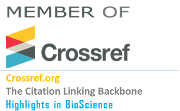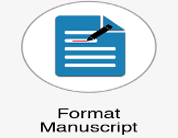Extraction, Characterization, and Usage of Turmeric Curcumin for Color Coating of Metronidazole Tablets
Abstract
Keywords
Full Text:
View Full TextReferences
Allen L, Ansel HC. Ansel's pharmaceutical dosage forms and drug delivery systems. Lippincott Williams & Wilkins; 2013 Dec 23.
Carter SJ. Cooper and Gunn's Dispensing for Pharmaceutical Students (12th Edn) Publisher. 47-50
Anderson AM, Mitchell MS, Mohan RS. Isolation of curcumin from turmeric. Journal of chemical education. 2000 Mar;77(3):359
Aggarwal BB, Harikumar KB. Potential therapeutic effects of curcumin, the anti-inflammatory agent, against neurodegenerative, cardiovascular, pulmonary, metabolic, autoimmune and neoplastic diseases. The international journal of biochemistry & cell biology. 2009 Jan 1; 41(1): 40-59.
Leong-Škorničková J, Šída O, Jarolímová V, Sabu M, Fér T, Trávníček P, Suda J. Chromosome numbers and genome size variation in Indian species of Curcuma (Zingiberaceae). Annals of Botany. 2007 Sep 1; 100 (3): 505-26.
Goel A, Kunnumakkara AB, Aggarwal BB. Curcumin as “Curecumin”: from kitchen to clinic. Biochemical pharmacology. 2008 Feb 15; 75 (4):787-809.
Chandran B, Goel A. A randomized, pilot study to assess the efficacy and safety of curcumin in patients with active rheumatoid arthritis. Phytotherapy research. 2012 Nov; 26 (11):1719-25.
Balasubramanian K. Molecular orbital basis for yellow curry spice curcumin's prevention of Alzheimer's disease. Journal of agricultural and food chemistry. 2006 May 17; 54 (10):3512-20.
Grynkiewicz G, Ślifirski P. Curcumin and curcuminoids in quest for medicinal status. Acta Biochimica Polonica. 2012 May 14; 59 (2).
Chignell CF, Bilskj P, Reszka KJ, Motten AG, Sik RH, Dahl TA. Spectral and photochemical properties of curcumin. Photochemistry and photobiology. 1994 Mar; 59(3):295-302.
Sun YM, Wang RX, Yuan SL, Lin XJ, Liu CB. Theoretical study on the antioxidant activity of curcumin. Chinese Journal of Chemistry. 2004 Aug; 22(8):827-30.
BP. The British pharmacopoeia 2012.
http://repository.sustech.edu/handle/123456789/13398?show=full
DOI: https://doi.org/10.36462/H.BioSci.20206
Refbacks
- There are currently no refbacks.
Copyright (c) 2020 Eltoum and Elfaki

This work is licensed under a Creative Commons Attribution 4.0 International License.
...........................................................................................................................................................
Other "Highlights in" Journals
Highlights in Bioinformatics, Highlights in Chemistry, Highlights in Science, Highlights in Microbiology, Highlights in Plant Science
........................................................................................................................................
International Library of Science "HighlightsIn" is an Open Access Scientific Publishers, aiming to science and knowledge support












